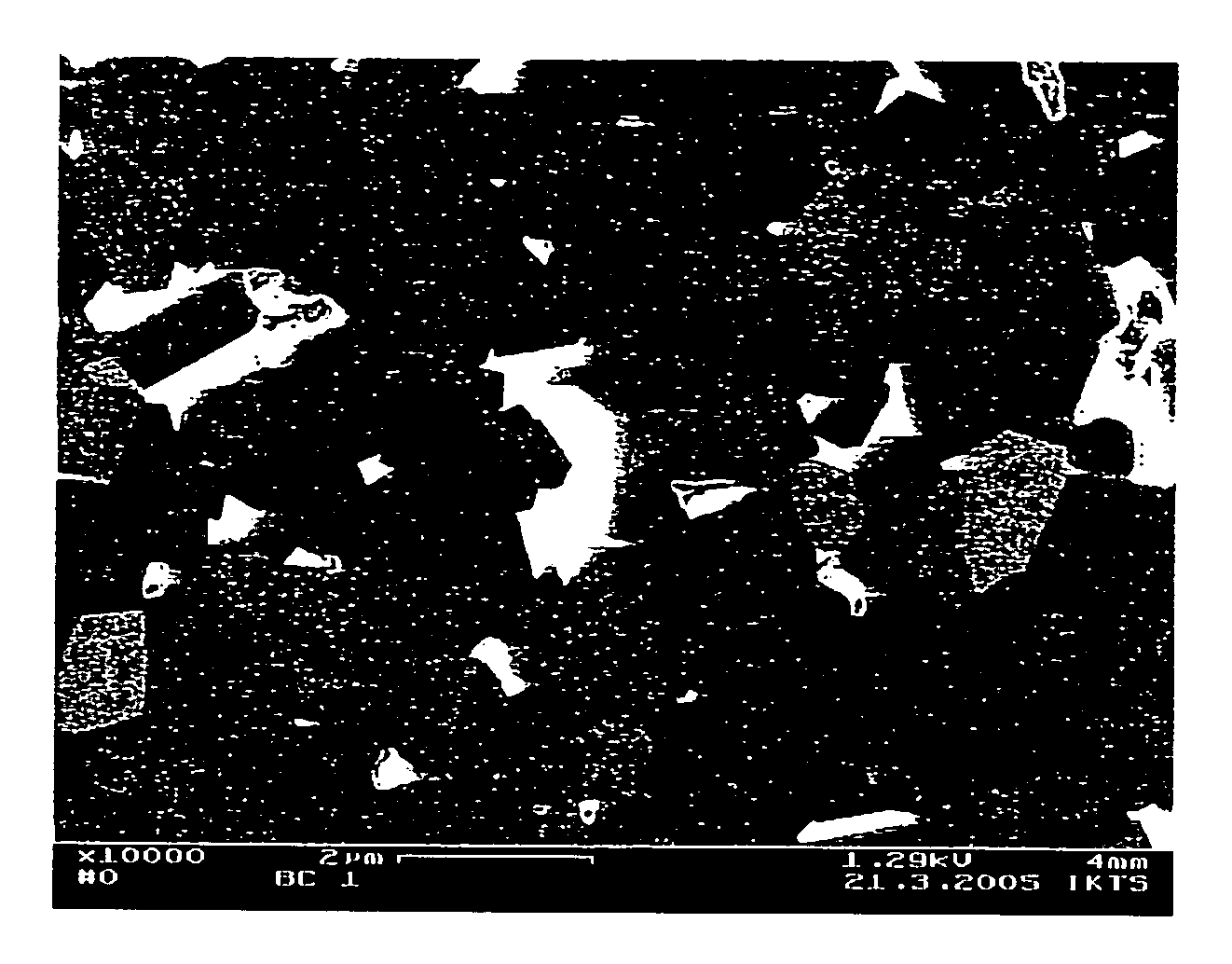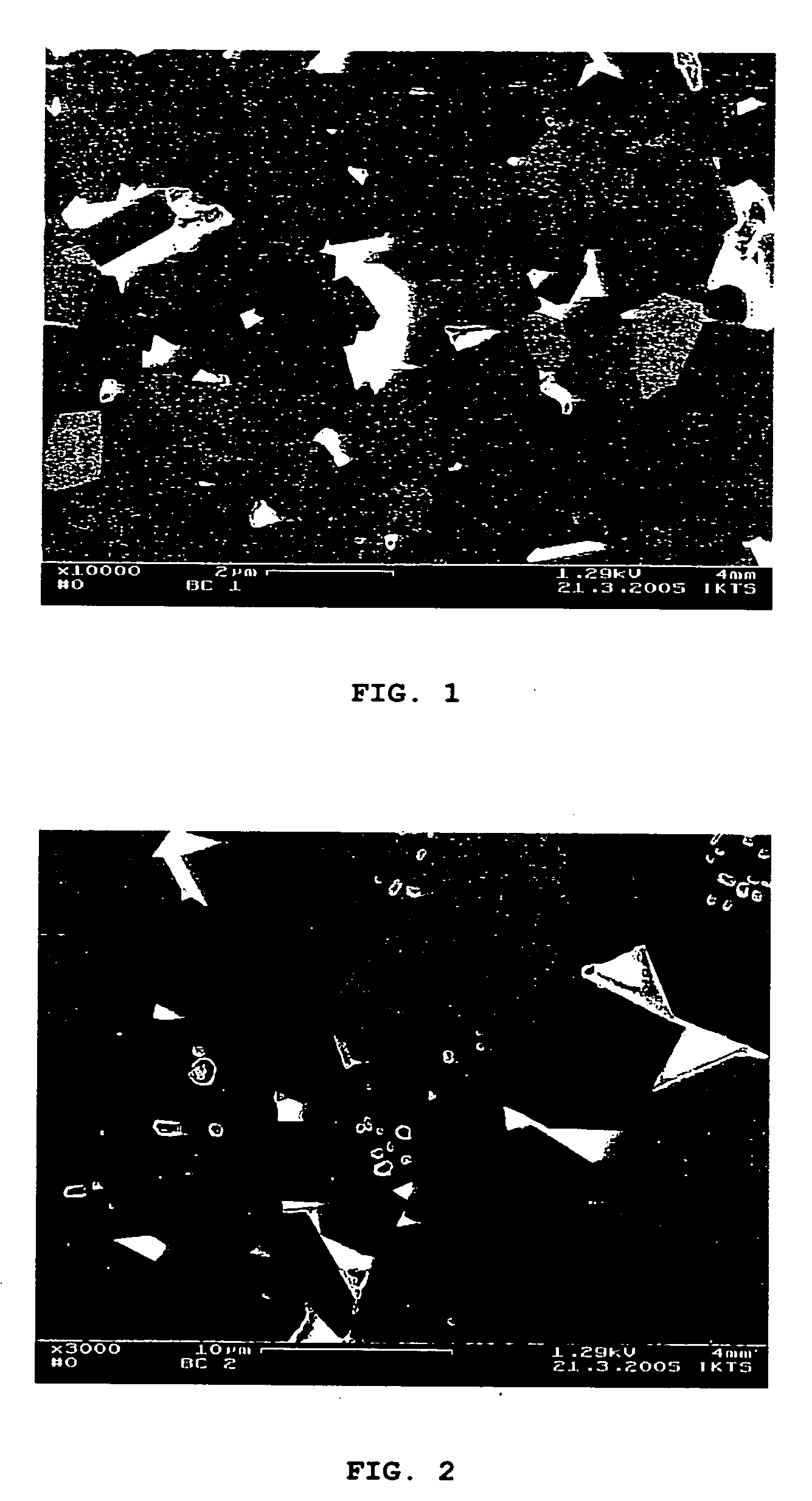Lightweight boron carbide materials with improved mechanical properties and process for their manufacture
a boron carbide and mechanical property technology, applied in the field of boron carbide sintered bodies, can solve the problems of high brittle low fracture toughness of boron carbide ceramics, and inability to establish itself as a structural material, etc., to achieve the effect of reducing the production cost of the material, high fracture toughness and hardness, and reducing the strength
- Summary
- Abstract
- Description
- Claims
- Application Information
AI Technical Summary
Benefits of technology
Problems solved by technology
Method used
Image
Examples
examples 1-10
[0052] A sub-micron grade B4C powder 1 μm and finer, with an average particle size of 0.6 μm was mixed in a water suspension with the sintering additives by stirring.
[0053] The B4C powder had a specific surface area of 17.6 m2 / g and had the following chemical composition:
B total76.7wt-%C total20.4wt-%C free0.8wt-%B2O31.5wt-%N0.3wt-%Si400ppmFe500ppmAl100ppmTi600ppmCa10ppm
(taking into account the free carbon and the boron present as B2O3 and the BN, corresponds to a B:C atomic ratio of this powder is 4.3).
[0054] As sintering additives used were fine aluminum nitride (AlN) powder in combination with fine yttrium aluminate, (Y3Al5O12), AlN in combination with yttria, alumina in combination with yttria and Y3Al5O12 in combination with alumina. The sintering additives had an average particle size finer than 10 μm and a specific surface area of 2-7 m2 / g. Aqueous slips were prepared in accordance with the formulations given in Table 1, with variation of the type and the quantity of the...
examples 11-19
[0062] A standard grade B4C powder 20 μm and finer with a mean grain size of 6 μm was mixed dry with “master mix”—a previously slurry homogenized and dried boron carbide, alumina powder (specific surface area 5 m2 / g) and a yttria powder (specific surface area 5 m2 / g). Also an aqueous slip of this B4C powder with Y3Al5O12 powder (specific surface area 4 m2 / g) alone was prepared.
[0063] The B4C powder had a specific surface area of 2.5 m2 / g and had the following chemical composition:
B total77.5wt-%C total21.2wt-%C free0.9wt-%B2O30.5wt-%N0.3wt-%Si300ppmFe700ppmAl100ppmTi200ppmCa30ppm
(which, taking into account the free carbon and the boron present as B2O3 and the BN, corresponds to a B:C atomic ratio of 4.2).
[0064] Total quantity of sintering additives was within the limits 2.0 to 8.3% by weight. The formulations mixed were (A) 2 wt-% Al2O3, (B) 5 wt-% Y2O3-3.3 wt-% Al2O3, (C) 4 wt-% Y2O3-2.6 wt-% Al2O3, (D) 3 wt-% Y2O3-2 wt-% Al2O3, (E) 2 wt-% Y2O3-1.3 wt-% Al2O3, and (F) 5 wt-% Y...
PUM
| Property | Measurement | Unit |
|---|---|---|
| Temperature | aaaaa | aaaaa |
| Temperature | aaaaa | aaaaa |
| Fraction | aaaaa | aaaaa |
Abstract
Description
Claims
Application Information
 Login to View More
Login to View More - R&D
- Intellectual Property
- Life Sciences
- Materials
- Tech Scout
- Unparalleled Data Quality
- Higher Quality Content
- 60% Fewer Hallucinations
Browse by: Latest US Patents, China's latest patents, Technical Efficacy Thesaurus, Application Domain, Technology Topic, Popular Technical Reports.
© 2025 PatSnap. All rights reserved.Legal|Privacy policy|Modern Slavery Act Transparency Statement|Sitemap|About US| Contact US: help@patsnap.com


